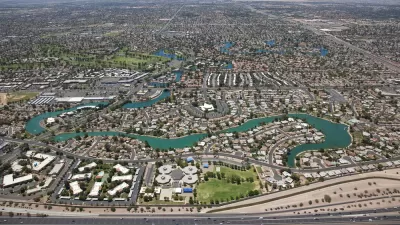This commentary from ArchNewsNow wonders whether urbanism is really the cause of social alienation, not the cure.
"The statistical revelation behind all of these findings is that for every 10% increase in density, there is a 10% decrease in socialization. That's a simple, one-to-one inverse relationship that everyone can understand."
"Of course this scientifically researched revelation begs the question, 'Why is this so?' The authors of the study suggest that "crowding associated with a dense environment might spur a need for privacy, causing people to draw inward. Such behavior could reflect the old saying: ‘good fences make good neighbors.'' The authors' conclusion is that 'density has been shown to exert a negative influence on social interaction, undermining an important line of attack used by critics of urban sprawl.' This may be an inconvenient truth for the New Urbanist movement, but this negative view of density is hardly new."
FULL STORY: Bowling Alone in Urbanistaville

Maui's Vacation Rental Debate Turns Ugly
Verbal attacks, misinformation campaigns and fistfights plague a high-stakes debate to convert thousands of vacation rentals into long-term housing.

Planetizen Federal Action Tracker
A weekly monitor of how Trump’s orders and actions are impacting planners and planning in America.

San Francisco Suspends Traffic Calming Amidst Record Deaths
Citing “a challenging fiscal landscape,” the city will cease the program on the heels of 42 traffic deaths, including 24 pedestrians.

Half of Post-Fire Altadena Home Sales Were to Corporations
Large investors are quietly buying up dozens of properties in Altadena, California, where a devastating wildfire destroyed more than 6,000 homes in January.

Opinion: What San Francisco’s Proposed ‘Family Zoning’ Could Really Mean
Mayor Lurie is using ‘family zoning’ to encourage denser development and upzoning — but could the concept actually foster community and more human-scale public spaces?

Jacksonville Launches First Autonomous Transit Shuttle in US
A fleet of 14 fully autonomous vehicles will serve a 3.5-mile downtown Jacksonville route with 12 stops.
Urban Design for Planners 1: Software Tools
This six-course series explores essential urban design concepts using open source software and equips planners with the tools they need to participate fully in the urban design process.
Planning for Universal Design
Learn the tools for implementing Universal Design in planning regulations.
Gallatin County Department of Planning & Community Development
Heyer Gruel & Associates PA
JM Goldson LLC
City of Camden Redevelopment Agency
City of Astoria
Transportation Research & Education Center (TREC) at Portland State University
Jefferson Parish Government
Camden Redevelopment Agency
City of Claremont





























